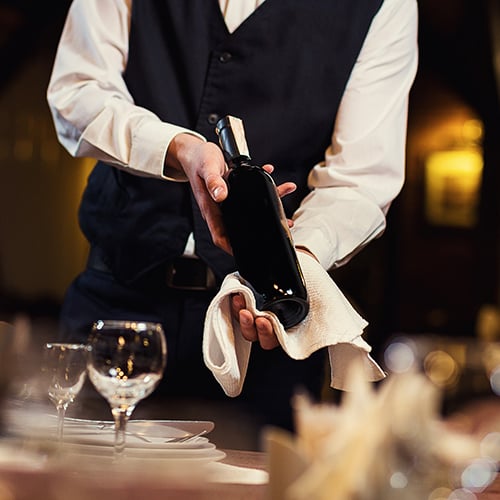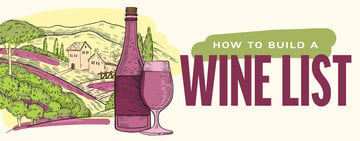Corkage Fee Guide
Offering your own selection of wines is a great way to boost alcohol sales, but there are situations where allowing customers to bring in their own bottle can add a personal touch. Patrons may be looking to pair a specific wine with a particular type of food, or they may just be looking to add some personal flair to a celebration or event. Regardless of the reasoning, there’s a lot to gain from establishing clear corkage fees and policies for customers to follow. Below, we’ve created a complete corking fee guide that you can use to ensure customers receive proper corking etiquette and have the best experience possible.
What Is a Corkage Fee?

A corkage fee is the price charged to guests who choose to bring their own bottle of wine to a restaurant. Corkage fees usually exist at restaurants that already serve wine. The practice of allowing guests to bring their own wine is considered a courtesy to guests. Occasionally, a bar or restaurant might charge a corking fee for providing their own wine as a means of raising their bottom line or covering their wine service costs.
Why Do Restaurants Charge a Corkage Fee?
A corkage fee includes the labor and cost involved in wine accommodations. The fee may cover some or all of the following amenities and efforts supplied by the bar or restaurant:
- Revenue lost from not purchasing the restaurant’s wine
- Use of restaurant or lounge space
- The restaurant’s investment in their own wine service program, including efforts related to curating a wine list, keeping a sommelier on staff, and training staff on their wine selection
- Accommodations relating to the wine (wine buckets, corking wine, or disposing of bottles)
Corkage Fee Costs

Below we provide information about average corkage fee costs and the reasoning behind differing fees.
How Much Is a Corkage Fee?
The average corkage fee ranges from $10 to $40 per bottle but may be as high as $100 or more. The price varies depending on the restaurant and may occasionally change according to the type of wine brought in. Some restaurants charge a corkage fee that matches the cost of their least expensive wine.
Are Corkage Fees Per Bottle?
In most restaurants, corkage fees are per bottle. Corkage fees might also be per table or per person (known as per glass or per "stem").
How to Calculate Corkage Fee
A restaurant’s corkage fee is usually commensurate with the level of service provided by the restaurant. So, a steep fee likely associates with a high-end restaurant that has elegant types of glassware, a wine list, and sommeliers. A lower fee, on the other hand, associates with less involved alcohol-related amenities and service. Guests might open their own wine, pour their own glasses, and use less-sophisticated glassware.
Corkage Fee Etiquette

Allowing guests to bring their own bottle of wine is considered a courtesy. As such, there is proper etiquette to follow when bringing your own bottle of wine. Below are some tips to follow if you want to bring a bottle to a restaurant.
- Understand the restaurant’s policy (if they allow it or not) along with their corkage fee. If you are unsure, it is best practice to call ahead if the information is not clear on a website.
- Make sure there are food options that will go with your wine.
- Bring the bottle in a carrier or on its own, not in a paper sack.
- The purpose of bringing your own bottle should not be to save money but to enjoy a unique bottle that is not provided by the restaurant.
- To get the best value out of a corkage fee, bring in a bottle valued more than the corkage fee.
- Offer the server and sommelier a taste as a sign of respect and camaraderie.
- Consider buying a bottle from the restaurant in addition to the one you've brought.
- Tip on the corkage fee.
Do You Tip on a Corkage Fee?
It is custom to tip on a corkage fee. In most instances, the corkage fee does not go to the server as a service charge but to the restaurant itself. Guests are expected to tip on the corkage fee in the same way they might for any other drink or food item.
Corkage Fee Tipping

Any extra effort the server goes through to accommodate you with regard to your wine is not reflected in the corkage fee, so tipping on your corkage fee is expected. The server will typically open the wine, pour it, refill glasses, store your wine at the proper temperature, and provide the appropriate stemware. It’s common to tip on the corkage fee in accordance with the level of service provided by your server.
How Much Do You Tip on a Corkage Fee?
If the service is satisfactory, it is recommended to tip the usual 15-20% on a corkage fee as you would any other food or drink item. Because the fee itself will usually be lower or higher depending on the service of the restaurant, your tip will fluctuate accordingly. For example, a $10 corkage fee would only add an extra $1-2 to your tip, whereas a $40 corkage fee yields an extra $8 to your overall tip, which will typically be appropriate if it is a high-end restaurant.
Do All Restaurants Have a Corkage Fee?
Not all restaurants have corkage fees. Restaurants that do allow you to bring in your own alcohol, even when serving their own wine, usually have corkage fees if you choose to bring in your own bottle of wine. On the other hand, bring-your-own-wine (BYOW) or bring-your-own-bottle (BYOB) restaurants typically have a low or nonexistent corkage fee.
If you want to bring your own bottle to a restaurant, always check with the restaurant to understand their policy.
Do BYO Restaurants Have Corkage Fees?
Many BYO restaurants don’t have corkage fees because they do not serve alcohol. Since they do not have cocktails, wine, or beer lists, the costs and services (sophisticated wine glassware, sommeliers, wine list) associated with alcohol-serving restaurants are less likely to be present. Therefore, BYOs do not need to make up for lost profit. In addition, BYO restaurants usually do not have a liquor license, and any cost associated with alcohol may be considered an unlawful charge by the restaurant for the alcohol. However, some BYO restaurants do have a corkage fee.
Corkage Fee FAQ
Below, we answer some of the most frequently asked questions surrounding corkage fees:
What Does Free Corkage Mean?
Free corkage means that the establishment has a corkage policy, but charges no money. These restaurants allow patrons to bring in their own bottles of wine and still perform wine service free of charge. Free corkage is typically offered during special events or occasions in order to entice potential customers.
What Is a Bottle Charge?

Just like a corkage fee, a bottle charge is a price charged to guests who bring their own bottles of wine. Depending on the restaurant, the two terms can be used interchangeably, but still refer to the same concept.
Waiving a Corkage Fee
If bringing your own bottle, some restaurants may waive the corkage fee if you also purchase a bottle of their wine. Additionally, some restaurants host $0 BYOB night, completely waiving the corkage fee with no additional purchase required. This is a great promotional event to attract new customers looking to bring their own wine.
Recorking Wine
Recorking wine is the act of taking partially-consumed bottles of wine home from a restaurant. Even if customers bring their own bottles, they are still beholden to recorking laws. Typically, wine bottles must be recorked or resealed before being taken home, but some state laws dictate they must be secured in a bag as well. Be sure to double-check your state laws before offering recorking services to patrons.
Whether customers want to celebrate a personal event with a sentimental bottle of wine or just bring along their favorite type, having proper corkage etiquette established at your business is beneficial. No matter what type of restaurant you operate, offering patrons the ability to bring their own wine allows customers to add a personal touch to their dining experience. Just make sure that your corkage policy is clearly established and that staff is trained on how to handle proper corkage etiquette. Doing so will make the overall experience much smoother for both customers and staff.








